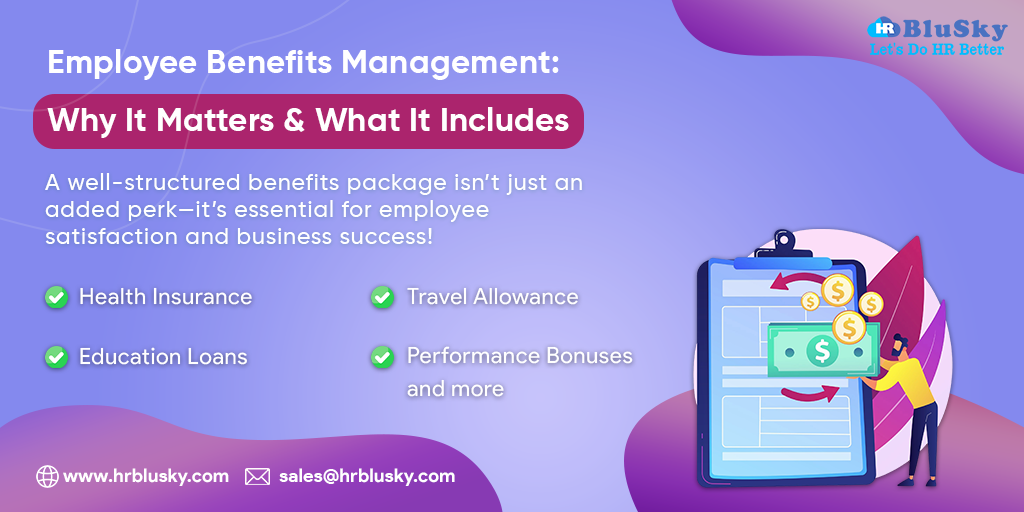
Menu

Menu

Employee benefits management are a key factor in workplace satisfaction, with 78% of employees stating that a strong benefits package influences their decision to stay with a company. Unlike direct salaries, benefits provide non-wage compensations that enhance financial security, well-being, and job satisfaction. Research shows that 60% of employees prioritize health insurance, while 48% value bonuses and incentives.
A well-structured benefits program not only attracts top talent but also improves retention and compliance. By implementing efficient employee benefits management, companies can streamline administration, track accruals, and integrate benefits with payroll, ensuring a seamless experience for both employees and HR teams.
Organizations provide employee benefits for multiple reasons, all of which contribute to the company’s long-term success. Some key reasons include:
1. Enhancing Employee Satisfaction: A survey by Glassdoor found that 79% of employees prefer better benefits over a pay raise. A strong benefits package increases overall job satisfaction, leading to a more engaged workforce.
2. Improving Employee Retention: Companies with robust benefits programs experience lower turnover rates. A study by MetLife revealed that 60% of employees say benefits are a crucial factor in staying with their employer.
3. Boosting Productivity and Performance: Providing comprehensive benefits such as health insurance, paid leave, and education loans reduces stress and financial burdens, allowing employees to focus on their work with greater efficiency.
4. Attracting Top Talent: Competitive benefits packages set organizations apart in the job market. According to a survey by SHRM, 92% of employees consider benefits crucial when deciding to accept a job offer.
5. Legal and Regulatory Compliance: Certain benefits, such as health insurance and retirement plans, are mandated by labor laws in many countries. Managing benefits ensures companies remain compliant with employment regulations.
Organizations offer various types of benefits to meet diverse employee needs. Below are some of the most essential benefits:
1. Health Insurance
Health coverage is one of the most sought-after employee benefits. It includes medical, dental, and vision insurance, helping employees manage healthcare costs and stay healthy. Research shows that 56% of employees say health benefits play a significant role in their job satisfaction.
2. Flight Tickets and Travel Allowances
For employees working abroad or those who travel frequently for business, flight tickets and travel allowances ensure convenience. Companies that offer these perks reduce financial stress for expatriates and improve job satisfaction.
3. Bonuses and Incentives
Performance-based bonuses, annual incentives, and profit-sharing plans motivate employees to work harder and align their efforts with organizational goals. Studies indicate that 72% of employees perform better when they receive performance incentives.
4. Education Loans and Tuition Assistance
Providing education loans or tuition reimbursement programs supports employees’ career growth. Employers investing in continuous learning see a 34% increase in employee retention.
5. Paid Time Off (PTO) and Leave Policies
Generous vacation and sick leave policies contribute to a better work-life balance. Research suggests that employees who take regular breaks and vacations are 31% more productive than those who do not.
6. Retirement Plans
Pensions, and provident funds help employees plan for their financial future. Companies offering retirement benefits see a 50% higher retention rate among long-term employees.
♦ Employee Request Handling: HR reviews and approves benefit requests, ensuring eligibility and compliance. They communicate with employees regarding policies and processing timelines.
♦ Ensuring Compliance: HR ensures all benefits align with labor laws and tax regulations, conducting audits to prevent legal risks.
♦ Monitoring Accruals: HR tracks benefit accruals, spreads costs throughout the year, and reports daily to maintain financial stability.
♦ Payroll Integration: HR ensures benefits are processed via payroll, direct cash payments, or bank transfers, eliminating delays or discrepancies.
♦ Requesting Benefits: Employees can submit benefit requests based on their eligibility criteria. This allows them to access the benefits they are entitled to, such as health insurance, bonuses, or travel reimbursements.
♦ Tracking Request Status: Once a request is submitted, employees can monitor the status of their application. This ensures transparency and keeps them informed about the approval process.
♦ Viewing Benefit Balance: Employees can check their remaining benefit amount and available allowances, helping them plan and utilize their benefits efficiently.
♦ Accessing Benefit History: Employees can review their benefit usage history, including previously availed benefits and accrued entitlements. This provides clarity on their benefit consumption and helps them make informed decisions.
A well-structured benefits package is essential for attracting and retaining top talent while improving employee satisfaction and productivity. It also ensures compliance with labor laws and optimizes costs.
At HRBluSky, we simplify benefits management with:
Automated Benefits Processing – Streamlines approvals and requests effortlessly.
Real-Time Accrual Tracking – Ensures accurate benefit allocation and financial planning.
Payroll Integration – Facilitates smooth settlements through payroll, direct payments, or bank transfers.
Compliance Management – Helps businesses adhere to tax regulations and labor laws effortlessly.
With HRBluSky, managing employee benefits is effortless. Request a free demo today!
Alignment
Article
Audit
Automation
Benefits
Candidate
Communication
Compliance
Digitalisation
Digital Technology
Diversity
Emirates Id Application
Employee Experience
ESS
Feedback
Health and Safety
HRMS
HR Strategy
HR System UAE
Human Resource Management
Human Resource Management Systems
Job Roles
Learning and Development
Onboarding
Outsource
Payroll
Payroll Management System
Payroll Processing
Performance
Performance Management
Personalisation
Recruit
Recruiting
Recruitment
Remote Working
Rewards
Security
Service Providers
Skills
Smart
Survey
Virtual
Visa Cancellation
Work Environment
Workforce
© 2025 Pruvity HR Solutions Pvt Ltd, Madurai, India
WhatsApp us